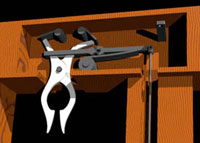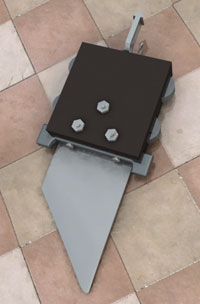The Crossbar
The upper crossbar containing the release mechanism.The grab holds the mouton in place until the the déclic (a handle on the side of the upright) is pushed down. This opens the jaws of the grab, and the mouton is released for its journey down. The metal door, which normally covers the internal mechanics, has been removed on this illustration.

The Mouton & the Blade
The Mouton is the weight that runs on two wheels in each groove. The spike on top fits into the sprunggrab of the crossbar. The blade is fixed to the mouton by means of three bolts.
The Déclic
The Déclic is a handle pulled down by the executioner to release the MoutonThe 1870 guillotine
Leon Berger an assistant executioner and carpenter improved and developed the construction of the guillotine in 1870-72.
This perfected the machine to the degree that all French guillotines manufactured after 1872 were based on his design.

The Lunette
This part of the guillotine is made of two wooden pieces, one fixed and one moveable. The lunette is copper lined at the side towards the blade. It is used to hold the neck of the condemned in position.
